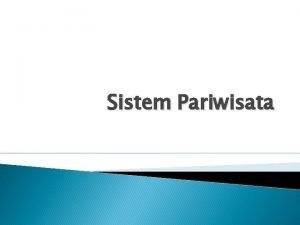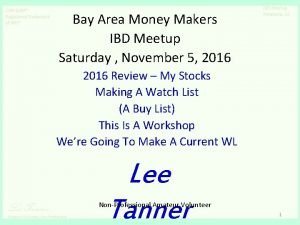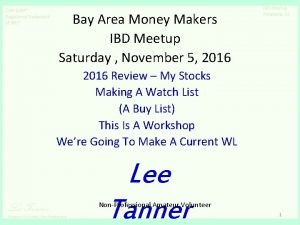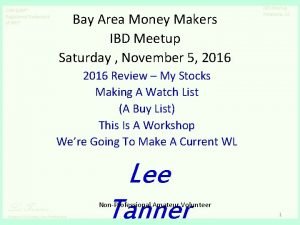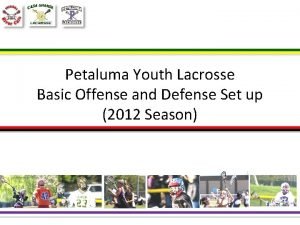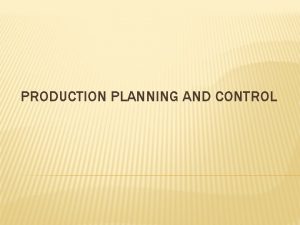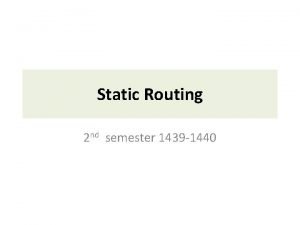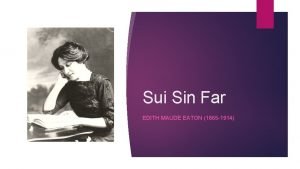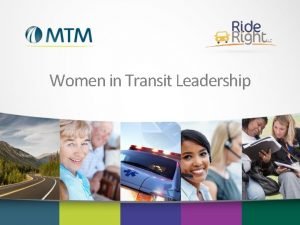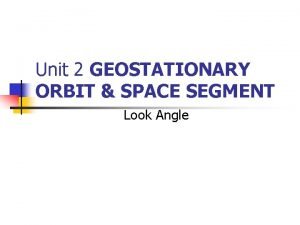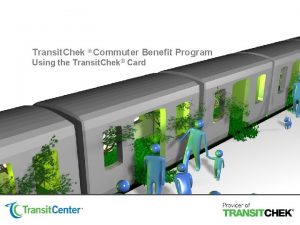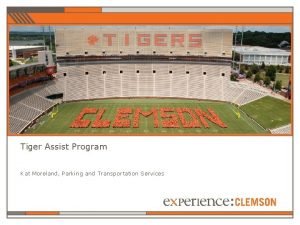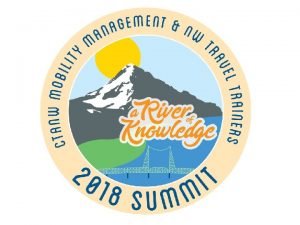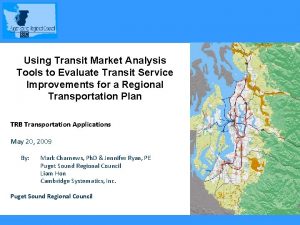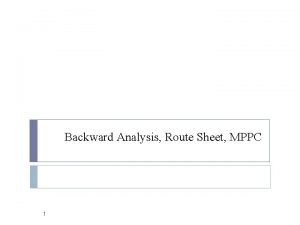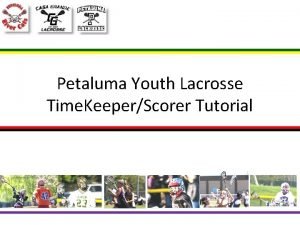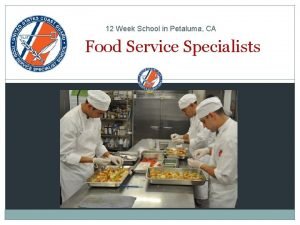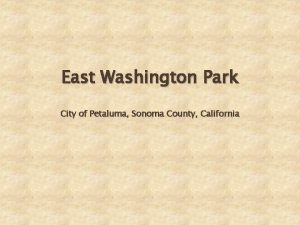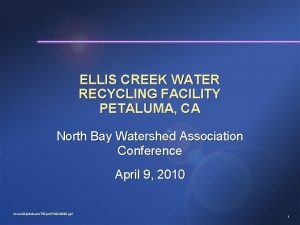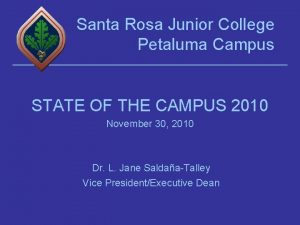Petaluma Transit Route Analysis Spring 2009 Summary of
















- Slides: 16

Petaluma Transit Route Analysis Spring 2009 Summary of Draft Report by West Coast Transit Solutions Conducted for City of Petaluma as part of 2009 Mini Short Range Transit Plan

Project Goals Adjustments to the printed schedules to improve on-time performance Adjustments to the printed schedules to improve driveability for bus operators Adjustments to the printed schedules to reduce rider travel times Gathering of rider origin and destination data, per route for planning purposes Collecting suggestions from operators and riders to improve the service Suggest preliminary ideas for route restructuring for further analysis

Route Analysis Methodology On board data collection over 4 day period April & May 2009. Base Data captured: route (day & time) info, schedule adherence, boardings/alightings by location, rider origin & destinations Bonus data captured from bus operators and PT passengers on various system issues

Findings: Current Schedules Both Route 1 schedules are too tight, drivers get inadequate recovery time: suggest deleting Westridge/Ridgeview 1 S segment and Howard/Oak 1 N segment Routes 2 S/N and 3 S/N have just minor timetable modifications needed (moving minutes around to keep bus moving, enable operator breaks at locations with facilities) Routes 3 S/N can be moved to (from : 00 and : 30 to : 15 and : 45) “pulse” with Routes 2 S/N at Copeland Transit Mall

Current Schedule Considerations Routes 2 S/N and 3 S/N spend 25% of their hour loop providing service and dwelling in the downtown area. Could do the core of their work in a 45 minute cycle if Downtown were covered well by another route (transfer). Route 1 is unproductive and would benefit from being the “downtown route” and connecting to Copeland Transit Mall Timing of changes: what to do with a simple brochure reprint, what should be part of public outreach process prior to implementation?

Route Productivity by Segment: Route 1 S: poor overall, some trips to medical offices by El Rose, a bit at 4 th & C. Route 1 N: poor but with better land use mix, could be productive on Petaluma Blvd North. Segment 10 samples 4 th & C to Mc. Near/Petaluma Blvd South* Petaluma Blvd S/Mc. Near to Grant & I to Sunnyslope & El Rose to Fair & Western to Bodega & Howard to 4 th & C Average Productivity Boardings Per Trip. 4. 1 0. 2 0 0. 7 Segment 9 samples 4 th & C to Keokuk/Magnolia* Magnolia/Keokuk to Petaluma Blvd North @ Factory Outlets Petaluma/Corona to Petaluma/Corona SB Petaluma @ Park N Ride to Factory Outlets Petaluma Blvd s/o Outlets to Petaluma/West Petaluma Blvd s/o West to 4 th & C Average Productivity Alightings Per Trip 0. 1. 1. 3 0 0. 5 Boardings Per Trip. 444. 333 Alightings Per Trip. 444 0. 333. 555 0 1. 67 . 111 0. 111 1. 00 2. 11

Route Productivity by Segment: Route 2 Segment 10 weekday samples, 2 saturday Transit Mall to Mc. Dowell/Madison to Washington Square S. Mc. Dowell/Maria to S. Mc. Dowell/St. Francis Casa Grande/S. Mc. Dowell to Frates & Lakeville & S. Mc. Dowell Ext to S. Mc. Dowell & Lakeville*** Lakeville & Marina to Washington & Lakeville Washington (River Stop) to Pet Market 4 th & C to Copeland Transit Mall Average Productivity Segment 9 samples Transit Mall to Maria & Greenbriar (Maria) to N. Mc. Dowell @ Lynch Lake(PV Hospital) N. Mc. Dowell & Rainier to Motel 6 on N. Mc. Dowell & Old Redwood Hwy to Montero & N. Mc. Dowell @ Redwood Gateway to Petaluma Plaza Shopping Center Washington & Mc. Dowell to River Stop Washington @ Petaluma Blvd to Keller (Petaluma Market) 4 th & C Average Productivity Boardings Per Trip 2. 50 1. 92. 83 Alightings Per Trip. 83. 67 1. 00 1. 50 1. 92 . 30 1. 20 . 08 1. 50 . 33. 67 8. 08 1. 25. 33 8. 75 Boardings Per Trip 1. 78 2. 11 Alightings Per Trip. 22. 78 1. 89 . 22 . 55 2. 22 1. 78 0. 00. 67 . 78. 22 . 33 8. 11 . 55 6. 77 2 S productive E/W on Washington, East Central (Washington Square), Far South (Casa Grande/Lakeville Resort/Kaiser) 2 N productive E/W on Washington, East Central (Washington Square), and all along North Mc. Dowell (Madison to Old Redwood)

Segment 14 samples Transit Mall to Washington & Petaluma Blvd (includes 4 th & C) Washington @ Copeland to Maria & Greenbriar Washington Square (Maria) to Casa Grande @ S. Mc. Dowell Casa Grande HS to Ely & Washington Sonoma Mtn. Parkway & Madison to Sonoma Mtn Parkway & Maria @ Meadow School to Maria @ Madison to Washington & Ellis Jefferson/Payran segment Copeland Transit Mall Average Productivity Boardings Per Trip 1. 43 Alightings Per Trip. 50 1. 00 . 64 . 71 1. 36. 64 . 43 1. 21 . 29 . 14 . 57 0. 08 0. 00 6. 01 1. 29 0. 08. 93 5. 93 Segment 19 samples Copeland Transit Mall to Washington & Petaluma Blvd. (includes Mkt & 4 th & C) Washington & Copeland to Maria & Greenbriar Washington Square (Maria) to Madison & N. Mc. Dowell Madison @ Novak (Sr. Center ) to Maria @ Meadow School ( ) Sonoma Mtn Parkway & Maria to Sonoma Mountain Parkway & Washington Ely & Washington to Casa Grande HS Casa Grande & S. Mc. Dowell to S. Mc. Dowell @ Washington Square Washington @ Ellis to Jefferson & Payran Copeland Transit Mall Route Productivity by Segment: Route 3 Boardings Per Trip 2. 42 Alightings Per Trip 1. 11 . 26 . 79 . 37 . 32 . 84 3. 26 1. 79 . 84 1. 53 1. 74 2. 26 . 37 0. 00 1. 00. 79 1. 26 3 S productive in East Central (Washington Square), along Ely & Sonoma Mtn Pkwy, & Crosstown to Downtown 3 N productive in East Central (Washington Square), along Ely & Sonoma Mtn Pkwy, & Crosstown to Downtown

Various WCTS Uncovered Issues Route 1 S does not work at all for two major schools along its current alignment because schedule 1 S buses arrive a few minutes after AM bell time. Contact Petaluma Jr. and Sr. High Schools and get bell time info. Make adjustment to schedules to arrive 1015 minutes or so before the AM bell, and 10 -15 minutes or so after PM bell. All routes (if possible) should meet at timed pulses at Copeland Transit Mall Routes 1 S and 1 N have terribly tight schedules, and even with paltry ridership they constantly are battling the clock, and operators rarely get even a small break to rest. Trim 3 -5 minutes from both routes for driveability. Bus stops along Maria on 3 N/S are very poorly marked (if at all). This segment is not a big producer of trips, especially outside the school-generated trips. Overall, Maria segment is OK south of Rainier, but is very low productivity north of Rainier. Need to keep 511. org updated. Riders showed us the 511 PT schedule printed today that was a couple years outdated. There are problems with making the AM pullout on time. Drivers are unable to build their air tanks in time to depart the yard for Copeland. Someone could start the buses 30 minutes before pull to give the buses time to warm up and air up. Operators are being instructed that only 2 timepoints per route actually count, and are running hot (early) frequently at intermediate timepoints per the current bus book. Several bus stop areas are filthy. Is there any process for cleaning the stops? Attractive bus stops with current service info would provide PT with instant credibility. Route 3 s are deviating to Keller (Petaluma Market) on request, but this isn’t shown on the schedule, and waiting passengers at Petaluma Market have no way of knowing if the bus will do this. Make a permanent part of the route. Novak Senior Center is hard to access from eastside, due to skipping on return trips of 3 N and no service on 3 S at all. This is pushing more seniors onto paratransit.

Various Rider & Driver Suggestions PT needs to somehow serve MHP on Stony Point Road, could do it with the cutaways by pulling into the park/clubhouse area then turnaround and return to town. Wishes there was a location in the far north to transfer from 1 N to 2 N. Cutoff the 2 s and 3 s at Copeland Transit Mall and extend the 1 s to meet the others there. Get rid of Howard Street segment of 1 N, slow and picks up nobody. Use Keokuk instead. Current last trip of 1 N (departs 5: 15 pm at 4 th and C, on modified pattern) is worthless, never picks up anybody. A 1 S at this hour may pick up some students at the schools, those with after school activities like sports. Need to generate correct service information, bus book is all wrong. No info @ stops. Trim 2 minutes off the new Montero timepoint on the 2 N, in order to allow the 2 N to get down to Petaluma Plaza Shopping Center (where people do a cross street transfer to the 2 S). Move it from : 40 to : 38. Trim 2 minutes off the Ely/Washington timepoint on the 3 S, change from : 31 to : 29 On 3 N, move timepoint from Columbard to Reisling, and shave several minutes off that segment. 3 N consistently has to sit 6 -10 minutes there for no reason, with no facilities for the drivers nearby, and usually bewildered passengers on board. 3 N at 7: 30 and 8: 30 am, and again at 2: 30 pm all 3 Ns skip the Washington Square loop (Maria) to save time (? ) but this causes confusion for riders and sometimes operators and isn’t really necessary. Too many “flag stops”, potential riders have no idea where to catch the bus.

Rider Origin & Destination Data Petaluma divided into 8 transit “zones” to attempt to isolate key travel patterns While some patterns emerge, duplicative nature of current routes, long one-way loops, reversing routes (3 S/N) data somewhat inconclusive Expansive community and current transit dependent ridership base pose challenge for route configuration; are they riding in this fashion by choice or because this is where the routes go? Obvious (main bell) school trips were EXCLUDED from O/D matrix to avoid skewing primary travel patterns, but some residual school trips (zero period, after school, etc) were included into O/D matrix

Route 1 Origins & Destinations Route 1 S/N both begin at 4 th and C. Route 1 S proceeds southerly using 6 th and 5 th to Mtn View, then serving a stop on Petaluma Blvd South before looping through the SW foothills with stops at both Petaluma Jr. and Sr. High Schools. Route 1 N proceeds from 4 th & C north via Howard-Oak-Keokuk to Magnolia, then north along Petaluma Blvd North to the Alternative HS on Industrial, returning downtown via Petaluma Blvd. Several activity centers exist on the 1 N, including the Factory Outlets. 1 S shows little productivity, with some potential along Petaluma Blvd South, and schools if schedule can be adjusted to better meet bell times 1 N not productive either, although potential exists along Petaluma Blvd North to Downtown, and school/Magnolia Apartments (adjust time? ).

Route 2 Origins & Destinations Route 2 S/N both begin at Copeland, and launch directly across Washington to Washington Square (East Central) where the 2 N turns north to provide service up and down North Mc. Dowell, and the 2 S heads south via Baywood & St. Francis to Casa Grande Road then further south to serve the Kaiser Medical and surrounding light industrial areas, returning to Copeland via Lakeville Highway. 2 S basically turns into a long, one-way loop. 2 N is a bi-directional service along N. Mc. Dowell. 2 S shows crosstown productivity, and Central & East Central to Far South. 2 N shows crosstown productivity, steady activity along N. Mc. Dowell & Central to NE, not skewed by school activity.

Route 3 Origins & Destinations Route 3 S/N both begin at Copeland, and launch to the west serving Downtown first, then sweep across town on Washington to Washington Square (East Central) where they provide loop service along S. Mc. Dowell-Casa Grande-Ely/SMP-Maria then returning to Copeland via Washington Square and Washington Street. Senior Center is served only in one direction. 3 S shows crosstown productivity, with SE to East Central & SE to NE trips (school induced? ), lots of boardings in SE 3 N shows high crosstown productivity between Downtown, Central and EC to NE. Strong SE to EC ties also. Strong SE-NE pattern is likely school induced and could be covered w/tripper?

Recommendations: First Phase Current Rider Guide inaccurate and only a few remain. Design simple and low-cost schedule brochure (tri-fold? ) for a “bridge” to Fall/Winter. Include timetable optimization into new brochure (Summer 2009), along with minor cuts to Route 1 S/N to enable operator recovery time. Defer further cuts to 1 S/N (to enable extension to Copeland) and truncation of 2 s and 3 s at Copeland for further study and public outreach. Search system for “hidden caches” of unproductive service that could be reallocated to evening 2 s and 3 s and/or Saturday services.

Recommendations: Longer Term During Fall 2009 outreach float concepts ideas such as 2 crosstown, bi-directional routes and Mc. Dowell Arterial services for riders to consider. Show AM and PM trippers to serve schools as needed. With current revenue hour commitment, most route schemes will lack adequate frequencies to appeal to riders with other options. Crosstown services will work far better with increased revenue hour availability (7 buses? ). Pursue options to increase available operations funds. Explore re-routing 1 S/1 N to focus more on productive segments and commercial areas. Consider converting 1 S/N to trippers (1 -2 trips in AM and PM at bell times) and offer general public paratransit to western neighborhoods (if needed). Reallocate 1 S/N hours to extend evening and weekend service on more productive routes. Explore further development of Washington Square area as secondary transit hub. Market and plan the service heavily to students and seniors!
 Elemen industri pariwisata adalah
Elemen industri pariwisata adalah Petaluma ibd meetup
Petaluma ibd meetup Lee tanner ibd
Lee tanner ibd Petaluma ibd meetup
Petaluma ibd meetup Friends of the petaluma river
Friends of the petaluma river Lacrosse 2-3-1 motion offense
Lacrosse 2-3-1 motion offense Route distinguisher vs route target
Route distinguisher vs route target Route card manufacturing
Route card manufacturing Spring summer fall winter and spring cast
Spring summer fall winter and spring cast Spring summer fall winter
Spring summer fall winter Summary static route
Summary static route Edith eaton
Edith eaton Mtm transit leadership
Mtm transit leadership Satellite look angle formula
Satellite look angle formula Transit chek
Transit chek Clemson tiger transit
Clemson tiger transit Pierce transit logo
Pierce transit logo
